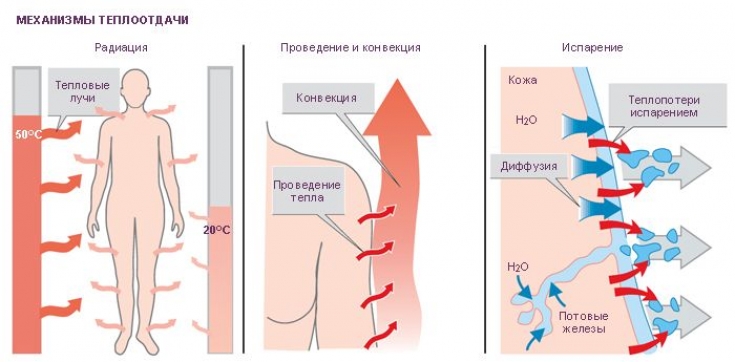Cosmetologists call excessive sweating one of the most common problems with which patients turn to them. There are many ways to solve this problem – depending on the causes of hyperhidrosis.
Hyperhidrosis – this is a condition associated with increased sweating in excess of the body's needs to maintain normal body temperature.
Hyperhidrosis is a dysfunction of the sweating system in which an excessive amount of sweat is produced. Excessive sweating may be a normal reaction to external stimuli or may be the result of an illness.
What are the types of hyperhidrosis
The main varieties of hyperhidrosis are primary (idiopathic) hyperhidrosis without a cause and secondary, which is symptomatic, occurs against the background of diseases. In terms of prevalence, it can be local (axillary, palmar and plantar) and generalized over the entire surface of the body.
Learn more: Treatment for facial hyperhidrosis: treatment for excessive facial sweating
Primary hyperhidrosis is most often localized. Secondary, more often generalized, occurs against the background of diseases of the endocrine system, neurological disorders, chronic infections, oncological diseases, side effects when taking medications.

requires careful history taking and diagnosis. This form of excessive sweating is a symptom characteristic of endocrine, infectious and neoplastic diseases. Therefore, first of all, it is necessary to differentiate local hyperhidrosis (as an independent clinical diagnosis) from generalized hyperhidrosis (as a symptom of the underlying disease).
Top 5 tips to get rid of excessive sweating in folk ways Treatment of excessive sweating as an independent problem is possible only in case of primary (local, essential) hyperhidrosis. In all cases of secondary hyperhidrosis, i.e. increased sweating associated with some other disease (infectious, endocrine, neurological), must be carried out in combination with an intervention on the primary disease.
Conservative treatments for excessive sweating
1. Use of antiperspirants.Aluminum chloride antiperspirants are most commonly used to treat excessive sweating. They are medical antiperspirants. As a rule, their use is most effective in the armpits, less effective – for feet and hands. Aluminum chloride constricts the ducts of the sweat glands by forming an insoluble precipitate at the duct of the sweat gland. The astringent action of aluminum chloride also has an effect on the narrowing of the sweat ducts.
2. The use of botulinum toxin type A in the treatment of hyperhidrosis.Botulinum toxin is most often used in axillary hyperhidrosis. The toxin affects the postganglionic sympathetic fibers of the sweat glands, blocking the release of acetylcholine at the endings of the cholinergic nerves that go to the eccrine sweat glands. These mechanisms lead to an anhydrotic effect (cessation of perspiration). On average, the duration of action of the drug is from 6 to 8 months with axillary hyperhidrosis. In palmar and plantar hyperhidrosis, the effect of botulinum toxin is much less, and the procedure is more painful.
3. Treatment with iontophoresis.A procedure in which an ionized substance penetrates under the skin under the influence of direct current without damaging it. The mechanism of action of this procedure is not fully understood. There are two theories. According to one of them, iontophoresis violates the electrical conductivity of the ducts of the sweat glands, while the second claims that as a result of the procedure, so-called plugs develop in the lumens of these glands. The effectiveness of this procedure is not observed in all patients.
 Surgical treatments for hyperhidrosis
Surgical treatments for hyperhidrosis
Surgical methods include endoscopic thoracic sympathectomy. The operation is low-traumatic, with a minimum of complications. Has contraindications. It is performed under general anesthesia. Effective against palmar hyperhidrosis.
Specialists have conducted a study on the possibility of treating hyperhidrosis with a non-invasive RF therapy method using the SPA RF Alma Lasers.
The study involved 52 women aged 19 to 46 years. With hyperhidrosis of the axillary region – 30 people, palmar form of hyperhidrosis – 10 people, 12 – with foot hyperhidrosis. The severity of hyperhidrosis was assessed using the Minor test before and after the procedure, 10 women were taken biopsy material in the axillary region after the first and after the fourth procedure. 4 procedures were performed weekly.
 To evaluate the effectiveness, Minor's test was performed before and after the procedure, as well as using the method of photographing and filling out a questionnaire. Also, an assessment of the psychological state of patients and an assessment of the quality of life before and after therapy, a biopsy of tissues in the axillary region were performed.
To evaluate the effectiveness, Minor's test was performed before and after the procedure, as well as using the method of photographing and filling out a questionnaire. Also, an assessment of the psychological state of patients and an assessment of the quality of life before and after therapy, a biopsy of tissues in the axillary region were performed.
Read more:
Excessive sweating: the most effective ways to fight The results of histological examination 24 hours after the procedure showed the onset of inflammation, the presence of leukocytes and eosinophilic infiltrate around the gland. 24 hours after the procedure, fibrosis was noted around the eccrine and apocrine glands. After 4 treatments, the glands did not show typical secretion.
The results of the study allow us to note that the treatment of hyperhidrosis can be carried out most effectively using RF therapy, which can significantly reduce the severity of hyperhidrosis and improve the quality of life of patients.
Source estet-portal.com






